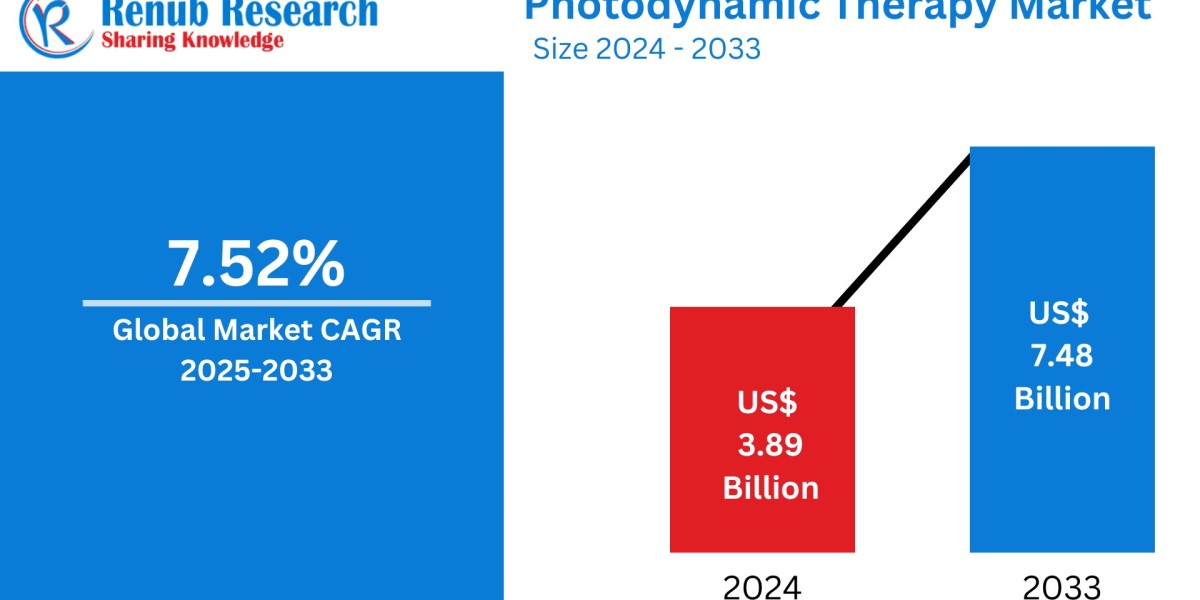Global Photodynamic Therapy (PDT) Market – Forecast 2025 to 2033
Market Overview
The global Photodynamic Therapy (PDT) market is expected to grow from US$3.89 billion in 2024 to US$7.48 billion by 2033, expanding at a CAGR of 7.52% during the forecast period. This growth is driven by rising incidences of cancer and dermatological disorders, technological advancements in light-based therapy devices, and growing patient demand for non-invasive treatments.
What is Photodynamic Therapy (PDT)?
Photodynamic Therapy is a minimally invasive treatment that uses photosensitizing agents and a specific wavelength of light to produce reactive oxygen species that target and destroy abnormal cells. PDT is particularly effective for:
- Cancer Treatment: Especially early-stage and localized cancers such as esophageal, lung, and bladder.
- Skin Disorders: Including actinic keratosis, acne, and psoriasis.
- Antimicrobial Action: Effective against drug-resistant bacteria and biofilm-related infections.
Key Market Drivers
1. Rising Prevalence of Cancer and Skin Conditions
- Over 35 million new cancer cases projected by 2050, a 77% increase from 2022.
- Increasing incidence of conditions like actinic keratosis, psoriasis, and skin cancer.
- PDT offers a targeted, effective, and less invasive alternative to surgery or chemotherapy.
2. Technological Advancements in Light-Based Therapies
- Development of next-gen LED and laser devices improves precision and efficiency.
- Launch of devices like RhodoLED XL (Biofrontera Inc.) and Heliance® (Hemerion Therapeutics®).
- Enhanced light penetration, biocompatibility, and usability boost adoption.
3. Growing Preference for Non-Invasive Treatment Options
- Patients and healthcare providers favor shorter recovery times and minimal side effects.
- Rising demand among the aging population vulnerable to cancers and chronic skin diseases.
- PDT's outpatient potential reduces hospital costs and burden on healthcare systems.
Challenges to Market Growth
1. High Treatment Costs and Reimbursement Gaps
- High costs of photosensitizers and light devices make PDT less accessible.
- Inconsistent insurance coverage, especially in developing regions, limits patient adoption.
2. Lack of Awareness and Training Among Providers
- Limited understanding among medical professionals regarding PDT's mechanisms and applications.
- Scarcity of training programs and certification courses impedes mainstream adoption.
Related Report
Anxiety Disorders and Depression Treatment Market
Infant Phototherapy Device Market
Market Segmentation
By Product Type
- Photodynamic Therapy Devices
- Photosensitizer Drugs
By Application
- Cancer
- Actinic Keratosis
- Psoriasis
- Acne
- Others
By End User
- Hospitals
- Cosmetic & Dermatology Clinics
- Cancer Treatment Centers
- Others
Regional Analysis
United States
- Growth driven by a high prevalence of cancer and skin disorders.
- Ongoing clinical trials (e.g., glioblastoma PDT at UPMC) show strong innovation.
- Market supported by a robust healthcare system and strong R&D investments.
France
- Rising adoption in oncology and dermatology.
- Government support for minimally invasive treatments.
- Challenges include device cost and provider awareness.
China
- Rapid expansion due to high patient population and evolving healthcare infrastructure.
- Local innovations and drug-device launches (e.g., Cevira® NDA by Asieris Pharmaceuticals).
- Key hurdles: urban-rural disparity, device affordability, and training.
Brazil
- Driven by rising skin cancer rates and growing healthcare investments.
- Government support and awareness campaigns help growth.
- Issues include high costs and limited access in remote regions.
Saudi Arabia
- Strong healthcare reforms and government push for innovation.
- Increased demand due to chronic disease prevalence.
- Growth restrained by costs and lack of trained professionals.
Photodynamic Therapy Device Market Highlights
General PDT Devices Market
- High demand for lasers, LEDs, and fiber-optic systems in treating cancer and dermatological conditions.
- Key barriers: high device cost and limited healthcare expertise.
Cancer PDT Devices
- Increasing application in localized cancer treatments.
- Rising awareness among oncologists and support from clinical evidence.
- Innovation and precision driving adoption despite cost hurdles.
Hospital-Based PDT Devices
- Growing use in outpatient care reduces patient recovery time and costs.
- Hospitals benefit from improved treatment outcomes and efficiency.
- Adoption still limited by technical know-how gaps.
Recent Developments
- June 2024: Biofrontera Inc. launches RhodoLED XL, FDA-approved red-light LED lamp.
- November 2024: Positive Phase 3 results from Ameluz + BF-RhodoLED therapy for sBCC.
- May 2024: Cevira® NDA accepted in China for treating HSIL, enhancing China’s PDT pipeline.
Conclusion
The Photodynamic Therapy market is set for substantial growth, fueled by increasing disease burden, advancements in light-based medical technology, and shifting preferences toward non-invasive treatments. However, to unlock its full potential, the market must address cost barriers, training gaps, and limited reimbursement. Strategic investments in education, innovation, and policy will be key to expanding PDT’s accessibility worldwide.
Top 10 Key Questions Answered in the Report
- What is the current global market size of photodynamic therapy?
- What are the major growth drivers of the PDT market?
- Which challenges are limiting market expansion?
- How is PDT used in cancer vs. dermatological applications?
- Which product types dominate the PDT market?
- How is PDT adoption evolving in hospitals?
- What role does technology play in shaping the PDT landscape?
- What is the forecast for PDT in major countries like the US, China, and France?
- Which companies and clinical trials are leading innovation?
- What is the outlook for insurance and cost accessibility in this market?








